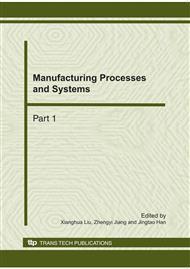p.1652
p.1656
p.1661
p.1668
p.1674
p.1680
p.1684
p.1689
p.1695
Research on Fitting Curve's Characteristics of Turbulence Motion Locus Based on Image Projection Transformation and Light Stream Vector
Abstract:
The variation discipline of turbulence motion locus during the process of bearing’s strengthening grinding is a difficult point in the research fields of fluid theory. For the purpose of obtaining accurate discipline of turbulence motion, the fitting curve’s characteristics of turbulence motion locus based on image projection transformation and light stream vector is investigated. Through tracing particles be equally-distributed scattered into flow field, they reflect turbulence’s motion discipline accurately. After each particle’s movement has been shot from different orientations in continuous time-points, thus sequential conjugate images have been obtained. Relationship of image projecting transformation is established for determining these particles’ absolute three-dimensional coordinates. Combining with light stream vector, these particles’ motion vectors in each instantaneous moment can be deducted and mathematical models of motion locus can be gotten. Then correlative mathematical characteristics are built, their variation tendency is analyzed in different flow velocities. This experiment provides theoretical foundation and technical preparation for research of complicated turbulence and selection of fluid signal sampling’s condition.
Info:
Periodical:
Pages:
1674-1679
Citation:
Online since:
October 2010
Authors:
Price:
Сopyright:
© 2011 Trans Tech Publications Ltd. All Rights Reserved
Share:
Citation:


